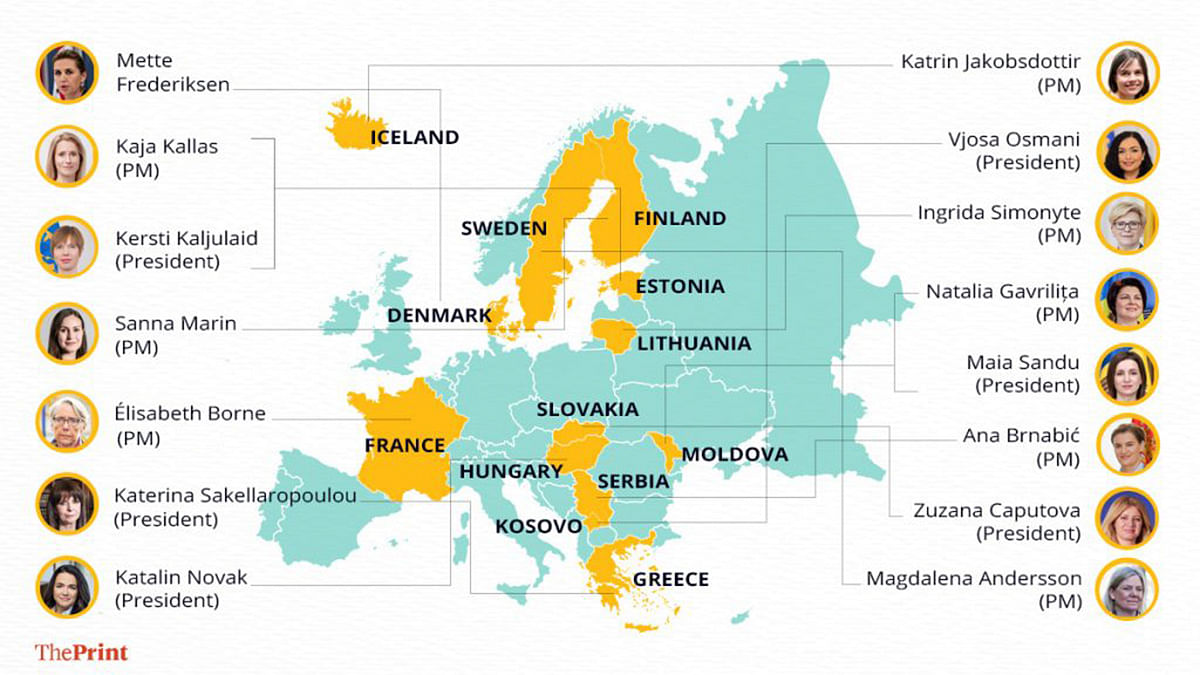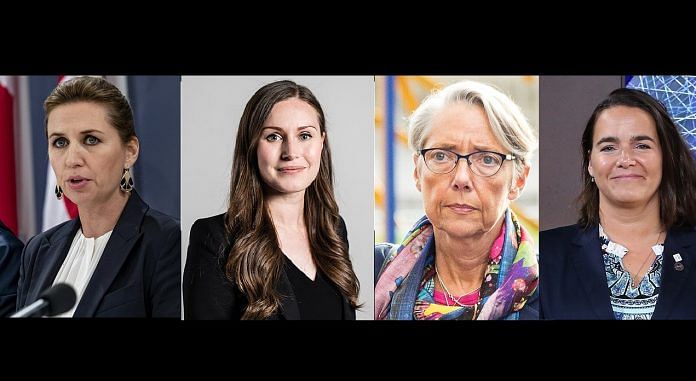As the Russia-Ukraine war enters its fourth month, and Europe faces its ‘darkest hour’ since World War 2, people in the region are turning to their political leaders to make sense of the shifting geopolitical landscape. A look at the leadership in the region reveals that women are either the head of state or head of government in 13 out of 45 European countries—the highest ever.
This was evident in the photographs from the second India-Nordic summit held in Copenhagen earlier in May. Prime Minister Narendra Modi and Norwegian PM Jonas Gahr Støre were the only men in a group of six heads of state. The four prime ministers from Denmark, Finland, Iceland, and Sweden are all women.
Other countries where women hold high positions of power in Europe include Moldova, Estonia, France, Greece, Hungary, Iceland, Kosovo, Lithuania, and Serbia.
The growing presence of female leaders in Europe may not come as a surprise given the legacies of the late Margaret Thatcher who was prime minister of the United Kingdom for 11 years and more recently Germany’s Angela Merkel, who stepped down as Chancellor last year after 16 years.

The women at the helm
That said, half serve as ceremonial heads with limited powers, but it is still the first time for many nations that they chose a female as their head of state. This includes Greece President Katerina Sakellaropoulou, Hungary President Katalin Novak, Slovakia President Zuzana Caputova, and Moldova President Maia Sandu. In Moldova — a rare case — both the head of state and head of government are women.
The women who hold real power as heads of government include Prime Ministers Mette Frederiksen in Denmark, Kaja Kallas in Estonia, Sanna Marin in Finland, Katrín Jakobsdóttir in Iceland, Ana Brnabić in Serbia and Magdalena Andersson in Sweden. The latter two deserve special mention as Brnabić is the first woman and openly gay PM in Serbia’s history while Andersson is the first female prime minister in Sweden’s history.
In January 2021, Estonia became the first country to have both a female elected head of state and a female head of government, but that changed last October when biologist-cum-politician Alar Karis replaced Kersti Kaljulaid, the youngest head of state, as president.
Also read: Meet the 4 Nordic women PMs whom Modi interacted with in Europe, all pioneers of climate action
What has led to this rise?
According to Ummu Bava, professor and Jean Monnet Chair, Centre for European Studies at Jawaharlal Nehru University (JNU), the rise of female leaders is due to factors such as progressive politics, better representation under EU programmes and the emergence of a younger generation.
“Angela Merkel and a few others set good examples for the women leaders we see in Europe today. But I think there’s a combination of factors leading to the recent rise. First, there’s been a general upward mobility in Europe as a result of welfare and progressive politics over the years. A lot of EU programmes have also helped push for greater political representation of women so this could be a reflection of that,” Bava said.
She pointed out that most of the women leaders such as Finland’s Sanna Marin are pretty young for the office they hold. “This younger lot is thinking differently about politics and representation.”
An analysis by The Print shows that of the 13 women leaders in Europe, the ones with executive power range from the age of 36-55 while the ceremonial heads are aged 40-65.
However, a woman in power is not a guarantee that democratic ideals will be upheld. In March, Hungary elected its first female president, Katalin Novak. A close ally of PM Viktor Orban, Novak was criticised as having ascended to the post strictly due to partisan factors. Though she portrayed her election as a “victory for women” and a progressive step for the country, critics have termed her “socially conservative” for championing anti-LGBTQ policies, among others.
“There has been a slide in democracy in Hungary in recent years that has created tensions with the EU. Orban is also pro-Putin. So, Novak becoming the first Hungarian female president could be viewed as sort of a strategic move and a deflection tactic when the EU tries to come down hard on the country for straying from the democratic path,” said Bava.
Also read: Not just 2020, why the US has never had a woman president
Far-right
It has been observed that many European women in top positions of power, even as party leaders, come from the right of the political spectrum. Thatcher and more recently Theresa May were from the UK’s Conservative Party. In France, Marine Le Pen, who ran against Emmanuel Macron in the recent French elections, is from the far-right National Rally party, increasing her vote share from the 2017 presidential elections. European Union chief Ursula von der Leyen also hails from the centre-right European People’s Party group.
Costanza Hermanin, a research fellow at the European University Institute’s School of Transnational Governance, examines this trend in a report for EuroNews. “Why is the part of the political spectrum that’s allegedly more attentive to gender equality — the left — having so many difficulties expressing a woman leader?”
There could be a few reasons, she adds, such as conservative women often portraying the traditional maternal figure championed by the right, though there isn’t a conclusive explanation.
According to Ishani Naskar, professor of International Relations at Kolkata’s Jadavpur University, women from the right are assumed to have strong “family values” and are therefore ‘trustworthy’.
“Leaders like Thatcher and Merkel had strong, traditional family values. When they were able to not just grab power but retain it, people’s trust in them grew. Then again, leading the country is still seen as a ‘masculine’ role in Europe, and women, even if they become heads of state or heads of government, continue to be seen through that lens,” said Naskar.
Special mentions
Within the constituent countries in Britain, women also lead from the front. Scotland’s First Minister is Nicola Sturgeon and Northern Ireland, which went to elections on 5 May, is likely to name Michelle O’Neill as First Minister, though an executive is yet to be formed.
It’s also important to mention Switzerland, a unique country that doesn’t really have a president or prime minister running the show. Rather, it has a seven-member Federal Council that serves as the collective head of state and government.
The seven councillors are heads of various government departments and the President of the Council position, currently held by Ignazio Cassis, is rotated on a yearly basis. There are currently three women in the Council — Viola Amherd who heads defence, civil protection and sports; Karin Keller-Sutter, who heads justice and police; and Simonetta Sommaruga, who heads environment, transport, energy and communications.
As Georgia is a transcontinental country (located in Europe and Asia) in which most of its population lives in Asia, it was left out of ThePrint’s list of 45 European countries. That said, the country elected its first female head of state, President Salome Zourabichvili, in 2018.
Also read: Under-representation of women in politics a narrative issue. Time to re-think the language
History of women leaders in Europe
Europe is no stranger to female leaders, though the first woman to head a government in the entire world was in Asia: Sirimavo Bandaranaike who became prime minister of Sri Lanka in 1960. In the sub-continent, women prime ministers such as the late Indira Gandhi and Benazir Bhutto changed the political landscape.
Bangladesh’s current PM Sheikh Hasina and Taiwan’s current President Tsai Ing-wen also prove that Asia is no stranger to female leaders either.
European countries started electing women as heads of state or heads of government from the late 1970s onwards. Many excelled at holding onto their power. Thatcher held her post as UK PM from 1979 until 1990 while Merkel served as German Chancellor from 2005 to 2021. Milka Planinc was the PM of former Yugoslavia from 1982-1986.
In the 2010s, many countries began electing their second or third female leaders like the UK with Theresa May and Poland with Ewa Kopacz.
Political analysts, historians and women rights activists point out that the current high tally of female leaders in Europe does not signify a tipping point. “Much more needs to be done before it becomes an unquestionable norm for women to lead from the front,” says Bava.
(Edited by Prashant)



